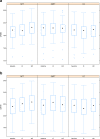Effects of acute bouts of endurance exercise on retinal vessel diameters are age and intensity dependent
- PMID: 24728623
- PMCID: PMC4082577
- DOI: 10.1007/s11357-014-9650-3
Effects of acute bouts of endurance exercise on retinal vessel diameters are age and intensity dependent
Abstract
Alterations of retinal vessel diameters are associated with increased cardiovascular risk. We aimed to investigate changes in retinal vessel diameters in response to acute dynamic exercise of different intensities and whether these changes are age dependent. Seventeen healthy seniors (median (IQR) age 68 (65, 69) years) and 15 healthy young adults (median (IQR) age 26 (25, 28) years) first performed a maximal treadmill test (MTT) followed by a submaximal treadmill test (SMTT) and a resting control condition in randomised order. Central retinal arteriolar (CRAE) and central retinal venular (CRVE) diameter equivalents were measured before as well as 5 (t5) and 40 (t40) minutes after exercise cessation using a static retinal vessel analyser. Both exercise intensities induced a significant dilatation in CRAE and CRVE at t5 compared to the control condition (P < 0.001). At t40, the mean increase in CRAE and CRVE was greater for MTT compared to that for SMTT (CRAE 1.7 μm (95 % confidence interval (CI) -0.1, 3.6; P = 0.061); CRVE 2.2 μm (95 % CI 0.4, 4.1; P = 0.019)). However, the estimated difference at t5 between seniors and young adults in their response to MTT compared to SMTT was 5.3 μm (95 % CI 2.0, 8.5; P = 0.002) for CRAE and 4.1 μm (95 % CI -0.4, 8.6; P = 0.076) for CRVE. Wider arteries and veins after maximal versus submaximal exercise for seniors compared to young adults suggest that myogenic vasoconstriction in response to exhaustive exercise may be reduced in seniors. Age-related loss of vascular reactivity has clinical implications since the arteriolar vasoconstriction protects the retinal capillary bed from intraluminal pressure peaks.
Figures




Similar articles
-
Retinal vessel caliber and the long-term incidence of age-related cataract: the Blue Mountains Eye Study.Ophthalmology. 2008 Oct;115(10):1693-8, 1698.e1. doi: 10.1016/j.ophtha.2008.04.005. Epub 2008 Jun 5. Ophthalmology. 2008. PMID: 18538403
-
Retinal vascular diameters in relation to physical activity in Danish children - The CHAMPS Eye Study.Scand J Med Sci Sports. 2018 Aug;28(8):1897-1907. doi: 10.1111/sms.13204. Epub 2018 May 21. Scand J Med Sci Sports. 2018. PMID: 29701884
-
Association of Central Retinal Arteriolar and Venular Equivalents with Brain-aging and Macular Ganglion Cell-inner Plexiform Layer Thickness.Ophthalmic Epidemiol. 2023 Feb;30(1):103-111. doi: 10.1080/09286586.2022.2057550. Epub 2022 Mar 28. Ophthalmic Epidemiol. 2023. PMID: 35343859 Free PMC article.
-
Physical activity and exercise improve retinal microvascular health as a biomarker of cardiovascular risk: A systematic review.Atherosclerosis. 2020 Dec;315:33-42. doi: 10.1016/j.atherosclerosis.2020.09.017. Epub 2020 Sep 23. Atherosclerosis. 2020. PMID: 33212315
-
Non-Invasive Retinal Vessel Analysis as a Predictor for Cardiovascular Disease.J Pers Med. 2024 May 9;14(5):501. doi: 10.3390/jpm14050501. J Pers Med. 2024. PMID: 38793083 Free PMC article. Review.
Cited by
-
Analysis of Retinal Blood Vessel Diameters in Pregnant Women Practicing Yoga: A Feasibility Study.Healthcare (Basel). 2022 Jul 21;10(7):1356. doi: 10.3390/healthcare10071356. Healthcare (Basel). 2022. PMID: 35885883 Free PMC article.
-
Quantification of Retinal Vessel Myogenic Constriction in Response to Blood Pressure Peaks: Implications for Flicker Light-Induced Dilatation.Front Physiol. 2021 Feb 18;12:608985. doi: 10.3389/fphys.2021.608985. eCollection 2021. Front Physiol. 2021. PMID: 33679432 Free PMC article.
-
Retinal Microcirculation Measurements in Response to Endurance Exercises Analysed by Adaptive Optics Retinal Camera.Diagnostics (Basel). 2024 Mar 28;14(7):710. doi: 10.3390/diagnostics14070710. Diagnostics (Basel). 2024. PMID: 38611623 Free PMC article.
-
Exercise and nutrition in type 1 diabetes: Insights from the FinnDiane cohort.Front Endocrinol (Lausanne). 2022 Dec 22;13:1064185. doi: 10.3389/fendo.2022.1064185. eCollection 2022. Front Endocrinol (Lausanne). 2022. PMID: 36619534 Free PMC article. Review.
-
Shifts in retinal vessel diameter and oxygen saturation in Chinese type 2 diabetes mellitus patients.BMC Ophthalmol. 2016 Apr 19;16:43. doi: 10.1186/s12886-016-0217-1. BMC Ophthalmol. 2016. PMID: 27095023 Free PMC article.
References
-
- Armstrong L, Balady GJ, Berry MJ, et al. ACSM’s guidelines for exercise testing and prescription. 7. Philadelphia: Lippincott Williams & Wilkins; 2006.
-
- Donath L, Zahner L, Cordes M, et al. Recommendations for aerobic endurance training based on subjective ratings of perceived exertion in healthy seniors. J Aging Phys Act. 2013;21:100–111. - PubMed
Publication types
MeSH terms
LinkOut - more resources
Full Text Sources
Other Literature Sources
Medical
